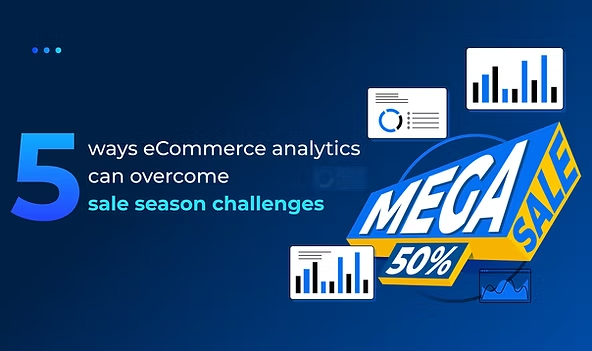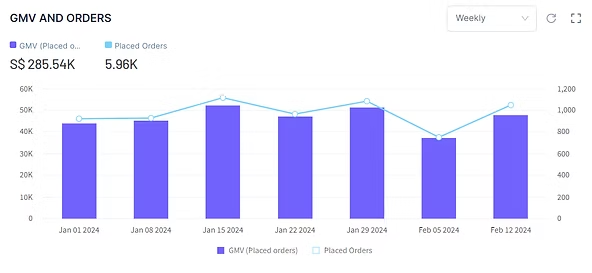
While festive and mega-campaign sale season is a great business opportunity, it comes with its own challenges. But sale season is not the time for errors, you need to be able to capitalize on consumer’s willingness to spend.
In this blog, we will cover the challenges associated with running festive/mega-campaign sales. We’ll also deep dive into how you can overcome these challenges easily without breaking a sweat using advanced eCommerce analytics.
Challenges online sellers face during festive/mega campaign sale seasons
5 ways eCommerce analytics can overcome the challenges
Leverage Graas for advanced eCommerce analytics
Some of the key challenges faced by online sellers during the sale season include:
The eCommerce industry is usually busy during holidays, festivals, or mega sales.
Competition rises between stores, between marketplaces, and between marketplaces and stores.
This heavy saturation makes it hard for companies to be unique and capture their target audience. It is crucial for sellers to be unique in one or more ways such as offers, express delivery or appealing marketing campaigns.
The increased competition means businesses fighting for the same spot — so whoever is willing to pay more wins!
During such seasons when orders are spiking, it usually puts pressure on the logistics networks. This leads to delivery delays and increased Return-To-Origin (RTOs).
RTO is a situation when people are unable to deliver an order so the package has to be returned to the seller which incurs more shipping costs, potential product damage, and customer dissatisfaction.
Managing these logistical hurdles while maintaining customer satisfaction becomes a significant challenge.
There are changes that take place in customer psychology and behaviors during the festive seasons. Consumers may exhibit different purchasing patterns, preferences, and spending habits compared to other times of the year.
They might also exhibit a high desire for deals and discounts. Importantly, as these shifts occur in real-time, it is essential for sellers to rescale their operations and offerings to leverage the spike in traffic and convert it into sales.
Devising strategies for these peak sales seasons comes with a lot of intricacies. Sellers are required to:
The stakes for getting these factors right are extremely high because such periods typically lead to a large share of sales within a calendar year.
Sale season is not the time for errors, you need to be able to capitalize on consumer’s willingness to spend. Here are five tried-and-tested ways advanced eCommerce analytics can help you.
Advanced eCommerce analytics capabilities allow you to predict trends and preferences for any future sales season, giving you a unique advantage over your competitors. This is done by analyzing past sale season data and making accurate predictions so you can be prepared with the right inventory levels, discount percentages, product lines, and more.
By continuously monitoring customer behavior, market shifts, and industry developments, tools like Graas can pinpoint both potential opportunities and threats to your business.
It presents these insights in a clear and actionable format, categorizing them as opportunities or threats and prioritizing them based on their potential impact on your gross merchandise value (GMV).

Another important area that eCommerce analytics can help with is in identifying better cross-sell and up-sell opportunities.
During the festive season, consumers are spoilt by the sheer amount of choice and discounts available. This, in turn, means that people will, and do, leave brands at the slightest hint of inconvenience.
To survive and maximize during this season, you need to create and deploy strategies that help you connect with customers, persuade them to shop with you, and become loyal to your brand.
One of the biggest advantages of digital advertising is the ability to target your ads to the right audience. In fact, 72% of marketers say that targeting the right audience is the most important factor in the success of their ad campaigns.
With advanced eCommerce analytics, you can use location-based analytics to tailor campaigns regionally. This means being able to develop region-specific campaigns that are culturally on point and allocate ad budgets accordingly as well.
Here’s an example of location-based ads from Zomato -


If you're an online store selling high-end women's handbags, your primary audience might be professional women aged 25 to 45 with a high income level. You can use demographic, interest, and behavioral data to ensure your ads are served to this audience.
You can then take this ad to the next level by identifying your top-performing city like Bangalore perhaps and run more ads in this area because the ROI will be better.
Additionally, use negative keywords to prevent your ads from showing up in irrelevant searches, such as "cheap women's handbags." Consider using advanced targeting features like location targeting or dayparting to reach your audience when they are most likely to engage.
With eCommerce analytics in place, you can get easy yet impactful product analysis of:
With this data, you can easily modify your inventory stock levels before the sale season starts so you’re better prepared and don’t miss out on any conversion opportunity.
With tools like Graas, you can even get a detailed analysis of forecasting demands based on other external factors like season type, festivity, etc.
Predictive analytics have helped eCommerce to synthesize big data into executable strategies that reallocate resources better.
For instance, let’s say you are running several promotional campaigns through Meta and Google Ads for the same product. Instead of just randomly splitting the money into two channels, predictive analysis can be used to determine what ROI is likely to be for each campaign.
The predictive models for ads, customer engagement, and conversions, in this case, take historical data into account to help determine which ad platform is likely to make the most money.
Furthermore, accurate attribution is essential for identifying the true impact of each marketing channel on your sales and overall business growth.
With the right eCommerce analytics tools, you can ensure that each sale is attributed to only one channel. This precise attribution helps you determine which marketing channels are performing best and which ones need improvement. By gaining clear insights into your top-performing and least-performing channels, you can make informed decisions on budget allocation.
Deciding whether to allocate more budget to Meta Ads or Google Ads will become much easier with accurate attribution data. This approach ensures a balanced strategy that not only drives conversions but also maintains the right level of brand awareness.
Analyze your customer’s shopping behaviors. Understand the journey each customer had with your brand, such as their frequency of shopping, when they engaged last, what’s their past-purchase track record like, etc.
Using this data, you can easily identify pain points in the buying journey and offer better user experience (like faster site speed) and customer service (like faster delivery options).
You can also create a customer journey map that’s specific to the festive season.
Creating a customer journey map lets you understand how your customers interact with your business and can help uncover ways to improve interactions throughout touchpoints - and this includes your offline stores.
Here’s how you can start mapping customer journeys:
To overcome these challenges and capitalize on festive season opportunities, businesses can turn to Graas for comprehensive eCommerce analytics solutions.
Graas provides comprehensive analytics solutions that empowers businesses to make data-driven decisions, optimize their strategies, and maximize profitability during mega sales.
With Graas, you can unlock the full potential of your eCommerce business with our all-in-one platform. With our seamless integration across all your data sources, powerful analytics, and cutting-edge AI tools, we've got everything you need to skyrocket your online business to new heights during the festive season.